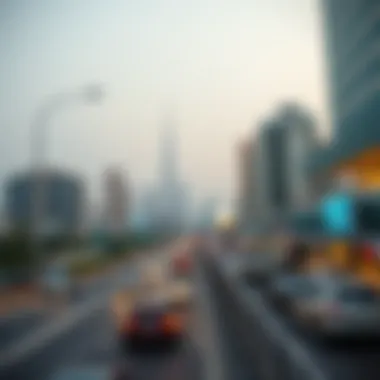Distance Insights: Dubai and Abu Dhabi's Real Estate Impact


Intro
As the sun rises over the horizon, casting its first rays on the bustling streets of Dubai and the tranquil avenues of Abu Dhabi, one can’t help but appreciate the rich tapestry of life in these two iconic cities. Located a mere distance of approximately 150 kilometers apart, the proximity of these metropolitan hubs has profound implications for residents and investors alike. For individuals considering navigating the real estate landscapes in either city, understanding the nuances of this spatial relationship becomes imperative. In this article, we will dissect not only the distance itself but also how this geographical factor impacts real estate opportunities and lifestyle choices.
The allure of Dubai, renowned for its extravagant skyscrapers and vibrant lifestyle, often contrasts sharply with the calm sophistication of Abu Dhabi, the UAE’s capital. Yet, this juxtaposition creates unique opportunities for investment and residential choices, particularly for those who may wish to benefit from the offerings of both cities.
Why Distance Matters
Understanding the gap between Dubai and Abu Dhabi extends beyond mere kilometers. It encapsulates factors such as commuting times, travel options, and the dynamic real estate market that exists at the intersection of these cities. The relationship between these cities speaks volumes about market trends, and acknowledging this can offer savvy investors a leg up in an increasingly competitive environment.
From commuting options that span luxury buses to high-speed rail, the ease of travel between these two thriving locales shapes the decisions of potential homeowners and renters. As one contemplates living in either city, lifestyle considerations will vary greatly depending on proximity, and the implications for real estate investments cannot be overlooked.
As we delve deeper into this analysis, we will explore the current market trends surrounding the real estate environment, providing clarity and actionable insights for investors and those seeking to buy or rent. With an eye on future projections, this exploration will highlight key areas likely to experience growth, ensuring informed decisions in a fast-paced economic landscape.
Exploring the Distance: An Overview
The different spacial relationship between Dubai and Abu Dhabi is a significant aspect when evaluating the real estate and lifestyle opportunities in these two cosmopolitan cities. Understanding the distance not only ties into the practicality of travel but also influences property investments, the choices for housing, and how these cities serve the growing, diverse populations that inhabit them. Knowing how far apart these cities are and what that means for daily life, including commuting time, amenities, and overall quality of home life, can help individuals and businesses make informed decisions.
Geographic Landscape
Dubai and Abu Dhabi are not just geographically distinct; they have unique characteristics that shape the way people experience them. Dubai, with its towering skyline and luxurious project, creates an image of modernity that attracts tourists and investors alike. On the other hand, Abu Dhabi, while equally sophisticated, offers a different vibe with its cultural heritage and more expansive environmental spaces.
The distance between the two cities is about 140 kilometers, usually interpreted as a manageable commute yet it does paint a picture of two types of living environments. The journey between them provides a beautiful desert landscape, flanked by massive sand dunes, and glimpses of traditional Bedouin culture juxtaposed with exceptional luxury. This geographical context can play a role in how individuals choose to connect with either city, influencing lifestyle choices and property valuation in tangible ways.
Measuring the Distance
When discussing distance, it's important to clarify what measurement standard is in use. The 140 kilometers between Dubai and Abu Dhabi can be measured in miles as well—roughly 87 miles for those more familiar with that standard. Both cities are strategically connected by the Sheikh Zayed Road, a major artery that provides a direct route conducive for commuters. This single highway alone cuts down travel time significantly compared to other routes, solidifying the practicality of living in one city while working or socializing in the other.
Moreover, as more infrastructure developments come into play—like the new expressways or public transit systems—the possibility of closing this distance continues to grow. When it comes to real estate, investors must consider how this distance will affect their ventures over time, especially as urban expansion pushes the boundaries of suburban development. The implications of distance become clear: they dictate not only lifestyle but also the economic tapestry of these two cities intertwined in a complex yet vibrant relationship.
Understanding the distance amidst the growth of both cities paves the way for informed real estate decisions, ensuring potential buyers and investors analyze ideal locations based on personal and financial criteria.
Travel Options Between Dubai and Abu Dhabi
The distance between Dubai and Abu Dhabi isn’t just a geographical detail. It's a significant factor that affects the daily lives of residents and the real estate market in both cities. The ways people can travel between the two locations shape not only their lifestyles but also their investment choices. Understanding the options available can provide crucial insights for potential investors contemplating property in either city, or for those simply weighing the pros and cons of making one city their home over the other.
Now let's take a closer look at the travel options available and how they impact the residents of both cities.
Roadways: The Essential Route
When it comes to moving between Dubai and Abu Dhabi, the roadways play a pivotal role. The Sheikh Zayed Road is the lifeline that connects these two urban centers. This highway is more than just a commuting route; it reflects the economic heartbeat of the UAE, facilitating the swift movement of goods and people. The journey can be made in roughly one hour, depending on traffic conditions, making it a viable option for daily commutes.
However, it's essential to keep in mind that rush hours can turn this seamless ride into a crawl, especially during the weekends when both cities are bustling. As a result, understanding traffic patterns is key to making the most out of this distance.
Public Transportation Availability
Getting from Dubai to Abu Dhabi via public transportation offers an economical choice for many residents and visitors. It's not just about comfort; it’s about accessibility. Public transport connects both cities efficiently, although it has its limitations. Let’s break it down further.
Bus Services
The bus services between these two cities are quite extensive. Operated by the Roads and Transport Authority (RTA) in Dubai and the Department of Transport in Abu Dhabi, the buses are clean and reasonably priced. They run regularly and offer a smooth transition from one city to the other.
One key characteristic of bus services is their affordability—riding the bus costs significantly less than other travel options. This makes it a favorite among residents looking to save money. However, the downside might be the time factor, as bus travel can take longer than using a private vehicle, especially with multiple stops along the way.


Moreover, unique features like onboard Wi-Fi in certain routes have made commuting more convenient, appealing to younger professionals who may want to catch up on work or entertainment during their journey.
Taxi Services
Taxis offer a more direct and personalized mode of transportation. Available at numerous points throughout both cities, taxis can be flagged down or booked via apps like Careem or Uber. The key selling point of taxis is their convenience; with the ability to pick up and drop off at any location in either city, they provide a door-to-door service.
However, one must be cautious of fares during peak hours, as rates can hike substantially. Although efficient, it may not be the best choice for daily commutes due to cost implications if undertaken frequently.
Ride-Sharing Options
Ride-sharing has taken off in the UAE in a big way. Options like Careem and Uber are attracting a loyal user base. These services combine the convenience of taxi travel with modern technology, allowing users to book rides via mobile apps while providing fare transparency.
A standout feature of ride-sharing is flexibility; riders can choose car types, from economical to luxury, catering to different budgets and preferences. However, like taxis, they can also be pricey during peak times or when demand surges, particularly during events and holidays.
Air Travel Considerations
Though less common for routine travel between Dubai and Abu Dhabi, there are air travel options available, primarily used for those flying in from other parts of the world or opting for private jet services. The flight is generally short, lasting around 30 minutes, but considering travel to and from airports, this option is usually impractical for everyday commuting.
Direct flights exist but mainly cater to specific demands; for instance, they may be necessary for corporate relocations or exclusive visitors. While this option is remarkable in speed, the conveniences affiliated with ground travel tend to make it less relevant for daily use.
In summary, the available travel options between Dubai and Abu Dhabi significantly influence lifestyle and investment decisions. Whether choosing roadways, buses, taxis, or ride-sharing, the mode of transport must align with personal or professional needs, making it a pivotal element in the broader context of real estate and lifestyle considerations.
Distance and Real Estate Value
The distance between Dubai and Abu Dhabi plays a pivotal role in shaping the dynamics of the real estate market in both cities. Understanding this relationship is essential for investors and future homebuyers who are keen to tap into the opportunities present in these neighboring urban centers. The proximity not only influences property prices but also dictates lifestyle choices, job opportunities, and overall investment potential.
Impact on Property Prices
When evaluating property prices within the context of geographic distance, several factors come into play. Properties located closer to key economic hubs tend to attract higher demand. For instance, apartments in Dubai's bustling Downtown area generally command a premium due to their accessibility to businesses, shopping districts, and entertainment venues. Conversely, areas further from such amenities may offer more affordable options, yet they could lack the allure for many potential buyers.
Factors to consider include:
- Accessibility: The ease with which one can travel between the cities can significantly impact pricing. Regular commuters often price in their commuting times and costs.
- Market Dynamics: While the real estate market in Dubai is more fast-paced and competitive, Abu Dhabi is seeing gradual growth, which can make certain developments more attractive for potential buyers focused on long-term investment.
- Scarcity and Demand: Limited availability of land and properties in prime locations inflates prices. Investors keen on Dubai-centric developments may find that competition drives prices sky-high.
"The proximity to major economic drivers often spells the difference between high-value real estate and undervalued properties."
Investment Potential in Proximate Areas
Investors often look towards areas on the cusp of growth—proximity is a crucial marker for potential returns. Regions like Al Ain or Sharjah, situated between Dubai and Abu Dhabi, present unique investment prospects. With the right infrastructure developments, these areas can become attractive alternatives for those wanting the perks of both cities without the heavy price tag.
Key considerations regarding investment potential include:
- Emerging Neighborhoods: Investors should be on the lookout for neighborhoods that show signs of development. New housing projects or upgrades to public transport can shift interest towards these vicinities.
- Regulatory Support: Government initiatives aimed at boosting investment in certain regions can enhance their attractiveness further. Keeping tabs on such policies is essential for anyone looking to invest strategically.
- Demand vs. Supply: Areas that can balance supply with growing demand will stand to gain the most. Investors can benefit from understanding where the buyers are headed and what amenities they prioritize.
In summary, the implications of distance on real estate values intertwine with a myriad of economic and social factors. Investors and homebuyers alike must take a holistic view, considering not only the immediate costs but the long-term potential of their investments in this dynamic region.
Lifestyle Implications of Proximity
The distance between Dubai and Abu Dhabi is not just a matter of kilometers; it significantly shapes the lifestyle choices of residents and investors alike. Understanding the dynamics of these two cities helps unravel how proximity can affect daily life and property investment opportunities. Many individuals may view a short journey as trivial, however, in a bustling region like the UAE, the effects of closeness or distance are far-reaching. The implications of being just under 150 kilometers apart ripple out into various aspects of daily life, from commuting routines to access to cultural experiences.
Commuting as a Lifestyle Choice
Time Considerations
Time, as they say, is an asset more precious than gold. When it comes to commuting between Dubai and Abu Dhabi, there’s a delicate balancing act between time spent on the road and productivity. Daily commutes can range from 1.5 to 2 hours each way, depending on traffic conditions.


This characteristic of time consideration is crucial for anyone looking at property investment or residence in either city. The morning and evening rush hours can transform a straightforward drive into an endurance test. However, for many professionals, this has become somewhat of a norm; they’re willing to trade some of their time for the allure of living in Abu Dhabi’s quieter surroundings or the vibrant life in Dubai. One might say it’s a trade-off between peace and pace.
The unique feature here is that despite the long commute, individuals often employ the drive as a time for personal development—listening to podcasts, audiobooks, or even coordinating their day. This dual nature of the commute can present both disadvantages and advantages, providing an opportunity to maintain a conjunction between work and personal growth, yet it does risk getting consumed by the drudgery of daily travel.
Quality of Life Factors
Quality of life is another layer of consideration. Residents from both cities often evaluate their lifestyle based on what each location offers. Dubai exudes a dynamic, fast-paced vibe with endless entertainment options, while Abu Dhabi prides itself on cultural richness and a more laid-back atmosphere. This distinct difference attracts varied demographics. While some people appreciate the hustle of city life, others gravitate towards the serene palm-lined roads of the capital.
The main characteristic lying at the heart of quality of life factors is the availability of amenities and services. Dubai offers shopping malls, luxury hotels, and vibrant nightlife, making it appealing for younger individuals and expatriates. On the opposite end, Abu Dhabi boasts more family-friendly parks, cultural museums, and a community-centric lifestyle.
This difference can be advantageous for families looking for a quieter lifestyle while maintaining close professional ties to Dubai, as the accessible distance allows for easy transitions when needed. Yet, it is essential also to notice that living in one city while working in the other can catalyze stress from long commutes and limits the time available for leisure—demanding careful consideration for potential buyers.
Cultural Exchange Between Cities
Cultural exchange is an integral aspect of living near two major urban centers. The melting pot of cultures in both Dubai and Abu Dhabi adds a rich layer to everyday experiences. People often find themselves benefitting from an exciting mix of activities, festivals, and culinary delights, which stretch beyond the barriers of city borders. This fluidity between lifestyles bolsters not just personal relationships but expands the professional networks that can thrive amid the vibrancy of both cities.
The impact of this exchange also resonates in the real estate sector. Investors and buyers are intrigued by neighborhoods that can offer exposures to diverse backgrounds, especially in an increasingly globalized market. The proximity brings access to various cultural events—from art exhibitions in the Louvre Abu Dhabi to global music acts in Dubai. Such opportunities foster community bonds, encouraging potential buyers to consider not just the property, but also the lifestyle rooted in both cities.
As the UAE continues to grow, the inherent connection between Dubai and Abu Dhabi likely becomes more pronounced, urging investors, home buyers, and even casual observers to carefully analyze their decision-making through the lens of distance and its lifestyle implications.
Economic Factors Influencing the Market
Understanding the economic factors that influence the market between Dubai and Abu Dhabi is crucial for anyone looking to invest in real estate or consider moving to the region. These economic dynamics not only shape property values but also significantly affect lifestyle choices for residents and business owners.
Investors, home buyers, and property managers must closely monitor elements such as local economic growth, foreign investments, job creation, and infrastructural development. Each of these contributes to the overall health of the real estate market. For instance, if job opportunities increase in one city, it typically drives demand for housing in that area, potentially resulting in price spikes.
The relationship between Dubai and Abu Dhabi also plays a crucial part. As both cities grow economically, their interdependence remains evident. A thriving economy in one city can create ripple effects, benefiting the other and enhancing overall market viability.
Investment Trends
Investment trends between Dubai and Abu Dhabi reveal a landscape that is ever-changing, shaped by global economic conditions and local policies. Recently, there has been a noticeable shift towards more sustainable and smart city projects. Investors are now more inclined to put their money into developments that promise high returns on investment while being conscious of the environmental impact.
For instance, various mixed-use developments in both cities are catching the eye of investors because they blend residential, commercial, and leisure spaces effectively. Areas like Dubai's Downtown or Abu Dhabi’s Yas Island are prime examples where investors are seeing long-term benefits due to their strategic location and comprehensive planning.
Moreover, government initiatives aimed at easing foreign ownership restrictions are attracting international investors. Properties in areas like Dubai Marina or Saadiyat Island are now within reach for a broader audience, which boosts the market demand significantly.
Economic Connectivity
Economic connectivity between Dubai and Abu Dhabi sets the stage for further collaboration and growth. The ongoing expansions of the infrastructure such as the Abu Dhabi-Dubai Highway and public transit options enhance commuter access, making it more feasible for people to live in one city and work in another. This connectivity also creates opportunities for businesses to thrive across both cities.
Moreover, with developments like the Etihad Rail project, which promises to link key economic hubs across the UAE, we can expect an even tighter integration of the two markets. This connectivity not only serves to aid daily commuters but boosts retail, hospitality, and other sectors.
Overall, as Dubai and Abu Dhabi continue to intertwine economically, stakeholders in the real estate market must keep an eye on these factors to make informed decisions.
"Economic strategies deployed today will shape the landscape for not only the real estate market but the lifestyle of residents for years to come."
Investors seeking insights into the Dubai-Abu Dhabi market would do well to analyze both current trends and historical data. For additional background on real time economic statistics, check resources like Wikipedia and Britannica.
The interconnectedness of these two cities, driven by economic factors, underscores the importance of strategic thinking when investing in real estate. As trends evolve and economic landscapes shift, so should the approaches of those looking to capitalize on this thriving market.
Government Initiatives Affecting Accessibility
Government initiatives play a crucial role in shaping the physical and economic connectivity between Dubai and Abu Dhabi. As two key cities in the UAE, their mutual accessibility has direct implications on real estate dynamics and lifestyle choices. Initiatives aimed at improving transport infrastructure not only benefit commuters but also attract potential investors looking for lucrative opportunities in property and business sectors.
Infrastructure Developments


Highway Expansions
The expansion of highways, particularly the Sheikh Zayed Road and Abu Dhabi-Dubai Highway, has significantly shortened travel time between the two cities. This feature of highway expansion is central to fostering a seamless commute.
- Time Saving: With the recent expansions, the drive from one city to another has been reduced to about 1-1.5 hours, depending on traffic. This convenience makes living in one city while working in another increasingly feasible.
- Easier Access to Amenities: The expanded highways facilitate better access to shopping complexes, entertainment venues, and recreational spaces, making it easier for residents and visitors to explore both cities.
- Potential Downsides: While the expansions are certainly beneficial, one must also consider the increased traffic volumes. Higher numbers of drivers on these routes could, over time, negate the initial advantages of reduced travel times.
Public Transit Enhancements
Public transport has traditionally been a lesser preferred option for those commuting long distances in the UAE. However, recent upgrades to bus and taxi services have begun to turn the tide.
- New Bus Routes: The introduction of express bus services between Dubai and Abu Dhabi features a notable efficiency that enhances accessibility, especially for those who prefer not to drive. The frequency and reliability of these buses have made them an attractive option for many.
- Integration with Metro Systems: There's growing emphasis on connecting the two cities' public transport systems. Integration will allow commuters to switch seamlessly between various forms of transport.
- Challenges in Adoption: Despite enhancements, public transit may still be perceived as less comfortable compared to private vehicles. Some commuters might also find scheduling limitations an inconvenience, though these factors are gradually being addressed.
Policies Promoting Real Estate Investments
The UAE government actively seeks to encourage real estate development through a variety of policies that optimize accessibility and investment appeal. In recent times, notable reforms like long-term visas for property investors and flexible ownership laws have sparked interest in the property market.
These policies create a fertile ground for investment. Investors can look to capitalize on the enhanced connectivity between Dubai and Abu Dhabi, leading to greater demand for properties that offer a blend of lifestyle and business advantages. Land acquisition policies have also seen reforms aimed at simplifying processes, making the transition smoother for foreign and local investors alike.
Environmental Considerations
Understanding environmental considerations is essential when analyzing the distance between Dubai and Abu Dhabi. As urban areas grow, the balance between development and sustainability becomes crucial. This section delves into the significance of environmental aspects, the role of sustainability in urban planning, and the implications of urban sprawl on both cities.
Sustainability in Urban Planning
Sustainability is not just a buzzword; it’s a necessity, especially in rapidly developing regions like the UAE. For investors, home buyers, and property managers, recognizing sustainable practices in urban planning can lead to informed decisions. Here’s how sustainability plays a pivotal role:
- Efficient Resource Use: Builders and developers are focusing more on using resources wisely. This includes water conservation methods and energy-efficient technologies that reduce the impact on the environment.
- Green Building Certifications: Properties that hold certifications like LEED (Leadership in Energy and Environmental Design) often see better resale values. Those mark a commitment to sustainable practices, attracting eco-conscious investors and residents alike.
- Green Spaces Development: More parks and recreational areas are being integrated into urban planning, significantly improving the quality of life. Residents in areas with access to green spaces often report higher satisfaction and well-being.
Thus, making a commitment to sustainability not only protects the environment but also enhances property values over time.
“Building a sustainable future is not only good for the planet, it’s a smart investment for the future.”
Impact of Urban Sprawl
Urban sprawl refers to the uncontrolled expansion of urban areas into rural land, and it raises several concerns in both Dubai and Abu Dhabi. Understanding its implications is key for those looking to invest or reside in either city:
- Increased Traffic Congestion: As more people move to the outskirts, traffic issues can arise. Commuters face longer travel times, impacting lifestyle and potentially property values in those areas.
- Strain on Resources: Urban sprawl can lead to a strain on resources such as water and electricity. Investors should consider the sustainability of these resources in areas that are experiencing rapid development.
- Environmental Degradation: The spread of urban areas often leads to the loss of natural habitats and increased pollution. This degradation can impact the overall attractiveness of a location for future residents and investors.
As a result, urban sprawl challenges the equilibrium between growth and sustainability. Stakeholders must be mindful of these factors when considering their next investment in this region. Factors like traffic congestion and resource management can directly affect property desirability and price ranges.
Future Projections for Dubai and Abu Dhabi
Understanding the future dynamics between Dubai and Abu Dhabi is crucial for both investors and potential home buyers. As these two cities continue to evolve, their proximity has significant implications for real estate trends and lifestyle choices. By analyzing projections, we can uncover valuable insights into how these developments might shape markets and living experiences in the coming years.
Trends in Real Estate Development
Real estate development in Dubai and Abu Dhabi has witnessed a notable shift in recent years. Investors are increasingly looking at the connectedness of these two cities when making decisions. Key trends include the following:
- Increased Mixed-Use Developments: Both cities are embracing a trend toward mixed-use developments that integrate residential, commercial, and recreational spaces. This approach not only enhances urban life but also appeals to those seeking a live-work-play environment.
- Smart City Initiatives: Dubai and Abu Dhabi are also heavily investing in smart city technologies. Amenities such as advanced infrastructure, smarter traffic systems, and better public services demonstrate the focus on sustainability and efficiency, enhancing the allure of properties in the area.
- Luxury Market Growth: Despite economic fluctuations, the luxury real estate market remains strong. With a high net worth population increasing in both cities, the demand for premium properties is likely to persist, pushing developers to cater to this demographic.
In summary, these trends signify a robust market moving forward, presenting both opportunities and challenges as the landscape evolves in response to investor demands and shifting lifestyles.
Changing Demographics and Their Effects
The demographics of both Dubai and Abu Dhabi are shifting significantly. This change influences real estate, lifestyle, and urban planning in several ways:
- Increased Expatriate Population: A diverse expatriate community continues to settle in both cities. This blend of cultures presents unique opportunities for real estate that caters to varied tastes and preferences, making multicultural developments more desirable.
- Young Professionals and Millennials: Many young professionals are gravitating toward Dubai and Abu Dhabi for employment opportunities. This generation values convenience, technological integration, and vibrant community amenities, shaping the types of housing that developers focus on.
- Family-Oriented Developments: With more families considering the region, there is a push for family-friendly neighborhoods, complete with schools, parks, and family-centric amenities.
This altering demographic landscape implies that real estate investments need to adapt and consider not only the preferences of current residents but also the aspirations of newcomers looking to call these cities home.
"A city's growth is more than just a number of buildings; it’s the way those buildings create a vibrant community that matters."















